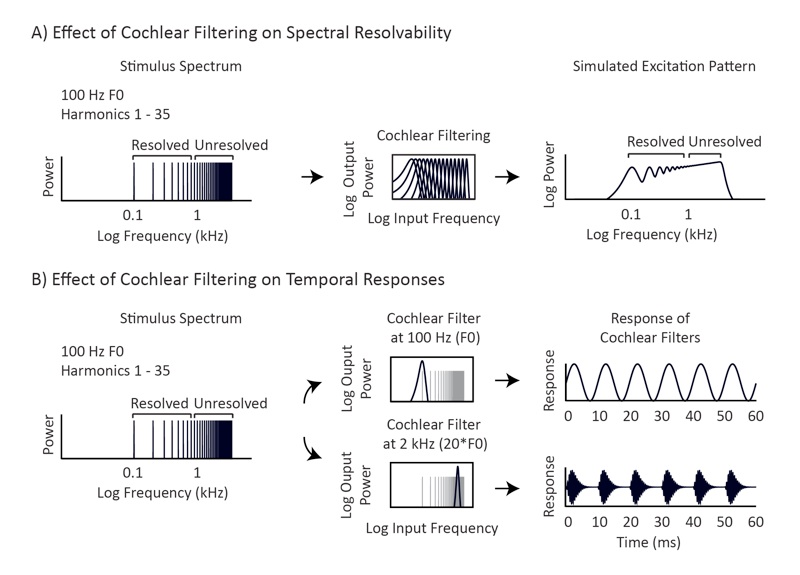
-
(A) Any periodic stimulus contains power at frequencies that are multiples (harmonics) of the F0. These frequencies are equally spaced on a linear frequency scale, but grow closer together on a logarithmic scale (as shown in the left panel). Cochlear filtering has the effect of smoothing the stimulus spectrum on an approximately logarithmic frequency scale (right panel). As a result, high-numbered harmonics do not produce discernible peaks in the cochlea’s excitation pattern and are therefore referred to as “unresolved”. Low-numbered harmonics, in contrast, do produce resolvable excitation peaks, thereby providing a spectral cue to pitch. The simulated excitation pattern shown at right (giving the magnitude of the cochlea’s response as a function of frequency) was computed from a bank of gammatone filters1,2 intended to mimic the frequency tuning of the cochlea. The middle panel shows the frequency response of the filters, which are approximately constant on a logarithmic scale (although they do broaden at low frequencies).
-
(B) Both low- and high-numbered harmonics produce periodic temporal fluctuations in the output of individual cochlear filters. The middle panel shows the frequency response of two example filters superimposed on the example stimulus spectrum. The right panel plots the response of each filter over a brief temporal interval.
Low-numbered, “resolved” harmonics (<8) produce spectral and temporal cues to pitch.
High-numbered, “unresolved” harmonics (>8) produce just temporal pitch cues.
Psychophysical experiments demonstrate pitch perception is much better for resolved harmonics3,4, suggesting the importance of spectral cues, but most neuroimaging studies mainly focus on unresolved harmonics5-8.
1Slaney M (1998) Auditory toolbox version 2. Interval Research Corporation Technical Report #1998-010. Available from: https://engineering.purdue.edu/~malcolm/interval/1998-010/
2Ellis DPW (2009) Gammatone-like spectrograms. Available from: http://www.ee.columbia.edu/ln/rosa/matlab/gammatonegram/
3Houtsma AJM, Smurzinski J (1990). Pitch Identification and discrimination for complex tones with many harmonics. J Acoust Soc Am.
4Shackleton TM, Carlyon RP (1994). The role of resolved and unresolved harmonics in pitch perception and frequency modulation discrimination. J Acous Soc Am.
5Griffiths TD, Buchel C, Frackowiak RS, Patterson RD (1998) Analysis of temporal structure in sound by the human brain. Nat Neurosci.
6Patterson RD, Uppenkamp S, Johnsrude IS, Griffiths TD (2002) The processing of temporal pitch and melody information in auditory cortex. Neuron.
7Hall DA, Barrett DJ, Akeroyd MA, Summerfield AQ (2005) Cortical representations of temporal structure in sound. J Neurophysiol.
8Barker D, Plack CJ, Hall DA (2011) Human auditory cortical responses to pitch and to pitch strength. Neuroreport.
